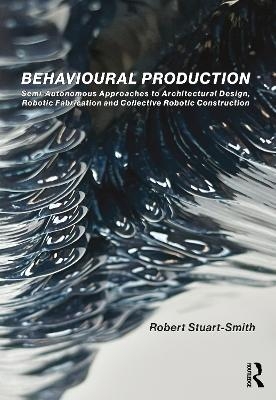
Behavioural Production
Routledge (Verlag)
978-0-367-46341-0 (ISBN)
- Noch nicht erschienen (ca. Juli 2024)
- Versandkostenfrei innerhalb Deutschlands
- Auch auf Rechnung
- Verfügbarkeit in der Filiale vor Ort prüfen
- Artikel merken
Autonomous manufacturing and cyber-physical systems are key enabling technologies of the Fourth Industrial Revolution (IR4) which are currently being incorporated into the building design and construction industries. These emerging IR4 technologies have the potential to effectively improve construction affordability and productivity, address current and future building demand, and reduce the environmental impact of the built environment. However, design approaches that make use of IR4 technologies are still relatively unexplored. While automation, such as mass production, promotes standardised design solutions, design thinking that embraces varying degrees of autonomy can lead to unique and considered approaches to design on an industrial scale.
Behavioural Production: Semi-Autonomous Approaches to Architectural Design, Robotic Fabrication and Collective Robotic Construction explores design operating through the orchestration of spatiotemporal events. A multi-agent behaviour-based approach to computation is employed in architectural design and extended to individual and swarm-based robotic methods for additive manufacturing. Behavioural Production seeks to expand our capacity to engage with the world at large through varying degrees of autonomy. In an industrialised world where traditional craftsmanship has been marginalised and cannot scale to meet societal needs, this book speculates a means to bring scalable forms of creativity into the act of making. This is explored through the use of materials, generative algorithms, computer vision, machine learning, and robot systems as active agents in design conception and realisation. The book presents a collection of ideas, projects, and methods developed in the author’s design practices and research labs in the fields of architecture and computer science. This body of work demonstrates that engaging with semi-autonomous processes does not diminish authorship, but rather expands it into new forms of design agency that seamlessly integrate with emerging manufacturing and construction technologies whilst authoring distinctive design character.
Robert Stuart-Smith is Program Director of the Master of Science in Design: Robotics and Autonomous Systems degree (MSD-RAS) at the University of Pennsylvania, an Affiliate Faculty member in Penn Engineering’s GRASP Lab and Assistant Professor of Architecture. Stuart-Smith also directs the Autonomous Manufacturing Research Lab in Penn’s Department of Architecture and University College London’s Department of Computer Science. Stuart-Smith’s research explores generative approaches to design, robotic fabrication and collective robotic construction. Recent projects include the £1.2 million EPSRC project “Applied Off-site and On-site Collective Multi-Robot Autonomous Building Manufacturing” and a £2.4 million EPSRC research project into “Aerial Additive Building Manufacturing”, involving collaborations with industry leaders Cemex, Skanska, Mace, Burohappold, Arup, MTC, Ultimaker, and others. Stuart-Smith was also a co-founder of the experimental design practice Kokkugia and now directs architectural practice Robert Stuart-Smith Design, which focuses on projects closely aligned with his research activities. Stuart-Smith’s work has been published in journals including Nature, Science Robotics, AD Architectural Design, and Architecture D’Aujourd’hui, while he has given lectures and presentations at institutions including ETHZ, AA, UCL, CCA, MIT, RMIT, ICD Stuttgart, Angewandte, Strelka Institute, Paris-Malaquais, Tsinghua University, and others.
1. Autonomy: Orchestrating and Partnering with External Phenomena 2. Architecture and Autonomous Construction: Industry 4.0 and Robotic Building Technology 3. Generative Production: The Agency of Things 4. Autonomous Agents: Encoding Design Intent within 3D Graphical Space 5. Structural Agency: Encoding Structural Design within Formative Processes 6. Additively Manufactured Architecture: Form, Topology and Material organisation 7. Autonomous Perception: Leveraging Computer Vision and Machine Learning in Design 8. Adaptive Manufacturing: Towards Situated, Embodied Production 9. Aerial Additive Manufacturing: Explorations into Collective Robotic Construction 10. Behavioural Production: A vision for Autonomous Design, Manufacturing and Construction
| Erscheint lt. Verlag | 22.7.2024 |
|---|---|
| Zusatzinfo | 201 Halftones, color; 201 Illustrations, color |
| Verlagsort | London |
| Sprache | englisch |
| Maße | 178 x 254 mm |
| Themenwelt | Informatik ► Theorie / Studium ► Künstliche Intelligenz / Robotik |
| Naturwissenschaften ► Biologie ► Ökologie / Naturschutz | |
| Technik ► Architektur | |
| Technik ► Umwelttechnik / Biotechnologie | |
| ISBN-10 | 0-367-46341-5 / 0367463415 |
| ISBN-13 | 978-0-367-46341-0 / 9780367463410 |
| Zustand | Neuware |
| Haben Sie eine Frage zum Produkt? |
aus dem Bereich


